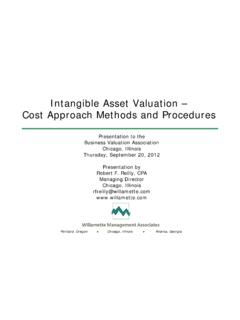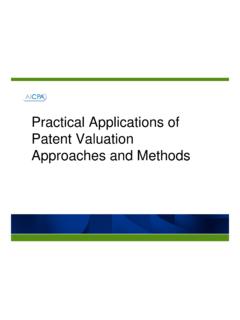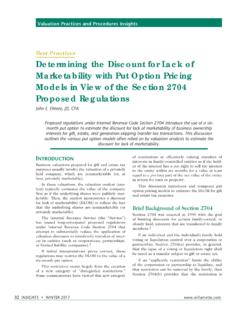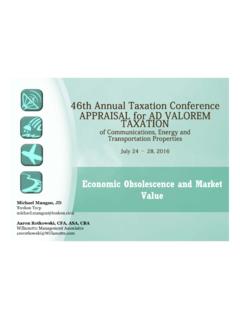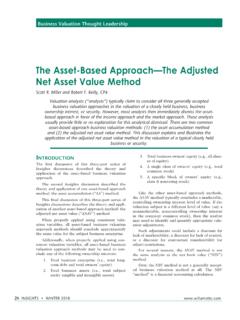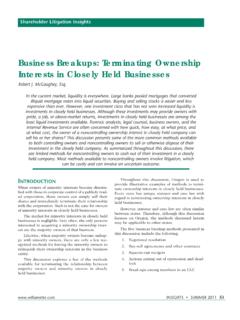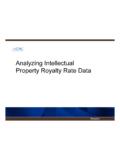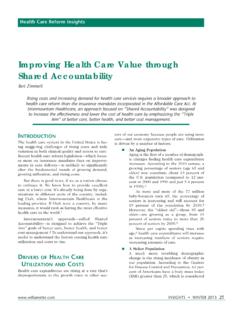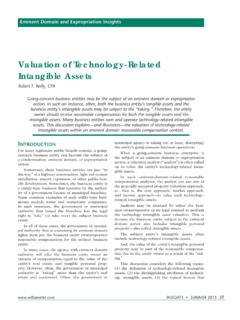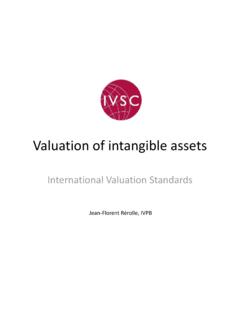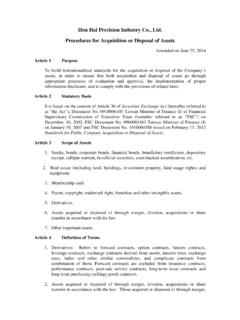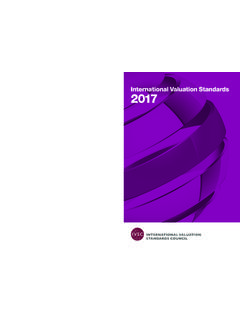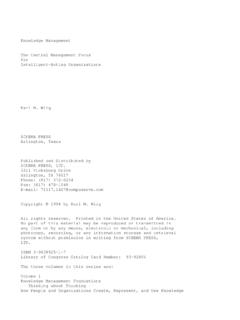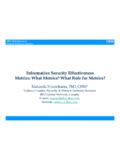Transcription of THE VALUATION OF COPYRIGHT-RELATED INTANGIBLE …
1 35 Autumn 2009 Insights THE VALUATION OF COPYRIGHT-RELATED INTANGIBLE ASSETSK atherine A. GilbertIntellectual Property VALUATION InsightsA copyright benefits from a specific bundle of legal rights that provides the author/creator the right to authorize or to prohibit the uses of the copyrighted work. Generally, the author of the original work owns the copyright , even though there are exceptions to this rule. Copyrights can be sold or transferred by assignment or by licensing. This discussion presents an overview of the generally accepted VALUATION approaches and methods that the VALUATION analyst may consider when performing a COPYRIGHT-RELATED INTANGIBLE asset a VALUATION perspective, COPYRIGHT-RELATED INTANGIBLE assets have similar economic and legal characteristics to other types of commercial intellectual property. These other types of commercial intellectual property include: trademarks, patents, and trade of these types of intellectual property are specifically protected by either federal or state statutes.
2 These statutes provide very specific economic and legal protection to (and, thereby, very specific develop-ment motivation to) the intellectual property , we will describe the factors that are relevant to the identifi-cation and VALUATION of COPYRIGHT-RELATED INTANGIBLE assets. Second, we will discuss the generally accepted copyright VALUATION approaches and methods. Last, we will present two simple examples, using two different analytical methods, to illustrate the VALUATION of copyright intellectual OF COPYRIGHT-RELATED INTANGIBLE ASSETSIn the following sections, we will consider each of these questions regarding the identification and VALUATION of COPYRIGHT-RELATED INTANGIBLE assets:1. What is a copyright and what economic advantage does it provide?2. What are the social and macroeconomic benefits of copyright protection?3. What types of creative works are subject to and not subject to copyright protection?
3 4. What are the various categories or types of copyrights?5. What is the legal term of federal copyright protection?6. What is the economic impact of copyright registration on the intellectual property owner?7. What are the common forms of ownership interest transfer of the copyright ?ECONOMIC BENEFITS ASSOCIATED WITH COPYRIGHT-RELATED INTANGIBLE ASSETSAs is true with all intellectual property, a copyright has a special set of legal rights and protections that is afforded to the copyright owner. These legal rights are the basis for the value of a copyright . And, these legal rights provide for the various commercialization opportunities related to copy-rights. These legal rights are summarized copyright provides for a bundle of exclusive rights that provides authors of original literary, musical, dramatic and As is true with all intellectual property, a copyright has a special set of legal rights and protections that is afforded to the copyright owner.
4 These legal rights are the basis for the value of a copyright . Insights Autumn 200936artistic works with the sole right to authorize (or prohibit) the following uses of their copyrighted works: to reproduce all or part of the work to make new (derivative) versions to distribute copies by selling, renting, leasing, or lend-ing them to perform (that is, to recite, dance, or act) the work publicly to display the work publicly, directly, or by means of film, TV, slides, or other device or processThe first three rights are violated when anyone copies, excerpts, adapts, or publishes a copyrighted work without permission. In rare cases, an author may dedicate a work to the public domain. However, unless the facts prove otherwise, the VALUATION analyst will typically assume that all original works published less than 75 years ago in the United States are protected by is noteworthy that the above definition uses the term author.
5 As it is mentioned above, copyrights cover a vari-ety of creative and artistic works many of which are not reason for this is that, under copyright law, the term author includes artists, composers, pho-tographers, computer software pro-grammers, and other individuals of creative talent in addition to writers. Also, since copyrights are sometimes granted to businesses, an author can be a corporation or other non-individual business , a copyright provides legal protection regard-ing the original expression of ideas. A copyright does not protect the ideas themselves. That is, an idea cannot be copyrighted. Rather, it is the expression of the idea the way the idea is presented that is copyright gives the owner the exclusive right to (and prohibits all other parties from the right to) perform, reproduce, alter, distribute, or display the original work of expression.
6 A copyright allows the owner to and prevents another party s ability to economically benefit from the original are several legal and economic similarities between copyrights and trade secrets. Some of these simi-larities are discussed and trade secret laws sometimes protect the same kinds of information. And, copyright and trade secret laws are sometimes mutually exclusive of each following discussion summarizes the salient points of how trade secret and copyright legal protections can work together under the copyright Act of 1976. Trade secret and copyright protection are both available for unpublished works as long as (1) the idea (or ideas) in the work are sufficiently innovative to qualify as a trade secret (any confidential information that provides a business with a competitive advantage) and (2) the information is kept confidential.
7 Trade secret and copyright protection may both be available for works that are distributed on a limited and restricted basis under a copyright licensing arrangement requiring the licensee (user) to recognize and maintain the trade secret aspects of the work. This dual protec-tion is especially important for the computer software business. Trade secret protection is generally not available for software if the source code is made available to the public on an unrestricted basis through such means as listing it in a computer magazine or on a medium of distribution (for instance, a compact disc). The deposit of a physical copy of the work that is being registered with the copyright Office operates to disclose any trade secrets in the work. This state-ment is true unless the deposit in some way masks the material that comprises the trade secret.
8 For instance, it is impos-sible to deposit samples of source code with major portions blacked out so that the parts of the code being maintained as a trade secret are not disclosed. There are several other methods for simultane-ously registering a computer program and maintain-ing trade secrets. One common way is to withhold the source code altogether and deposit object code which is impossible to understand when read in the copyright , the author of the original work owns the copyright . Again, with regard to copyrights, the creative person in any discipline ( , the artist, composer, or musi-cian, etc.) is called the are three exceptions to this rule regarding copy-right ownership:1. If an employee, in the normal course of employment, creates the copyright material, then the employer owns copyright and trade secret laws sometimes protect the same kinds of information.
9 And, copyright and trade secret laws are sometimes mutually exclusive of each other. 37 Autumn 2009 Insights the copyright . Such copyrighted materials are called work made for hire. 2. If the copyrighted material is commissioned by a patron and the patron and the author sign a work made for hire agreement, then the copyright is owned by the patron. An example of this may be the commission of a family or executive If the author sells the copyright , then the buyer owns the copyright . This statement is true regardless of whether the buyer is an individual, corporation, or some other form of of the material in a copyrighted original work does not have to be new. Inexperienced VALUATION analysts some-times believe that the compilations of the work of other authors are not subject to copyright protection. This belief is not correct.
10 In fact, the compilation of existing work itself may be considered an original expression sub-ject to copyright compilation is a copyright work that is the result of bringing together or arranging preexisting material (regard-less of whether that material is protected by copyright ) in an original or nonobvious protection is based on the original selection, coordination, or arrangement of the material, not the copyright status of the preexist-ing material are two types of compila-tions:1. fact compilations2. collective worksArranging public domain information, such as names and addresses or other data, in some minimally creative way creates a fact compilation. Common examples of fact compilations are electronic databases, directories, alma-nacs, price lists, and collective work is a special type of compilation cre-ated by arranging copyright elements in a single work.

